The changing epidemiology of bacillary dysentery and characteristics of antimicrobial resistance of Shigella isolated in China from 2004-2014
- PMID: 27863468
- PMCID: PMC5116132
- DOI: 10.1186/s12879-016-1977-1
The changing epidemiology of bacillary dysentery and characteristics of antimicrobial resistance of Shigella isolated in China from 2004-2014
Abstract
Background: Bacillary dysentery caused by bacteria of the genus Shigella is a significant public health problem in developing countries such as China. The objective of this study was to analyze the epidemiological pattern of bacillary dysentery, the diversity of the causative agent, and the antimicrobial resistance patterns of Shigella spp. for the purpose of determining the most effective allocation of resources and prioritization of interventions.
Methods: Surveillance data were acquired from the National Infectious Disease Information Reporting System (2004-2014) and from the sentinel hospital-based surveillance system (2005-2014). We analyzed the spatial and temporal distribution of bacillary dysentery, age and sex distribution, species diversity, and antimicrobial resistance patterns of Shigella spp.
Results: The surveillance registry included over 3 million probable cases of bacillary dysentery during the period 2004-2014. The annual incidence rate of bacillary dysentery decreased from 38.03 cases per 100,000 person-years in 2004 to 11.24 cases per 100,000 person-years in 2014. The case-fatality rate decreased from 0.028% in 2004 to 0.003% in 2014. Children aged <1 year and 1-4 years were most affected, with higher incidence rates (228.59 cases per 100,000 person-years and 92.58 cases per 100,000 person-years respectively). The annual epidemic season occurred between June and September. A higher incidence rate of bacillary dysentery was found in the Northwest region, Beijing and Tianjin during the study period. Shigella flexneri was the most prevalent species that caused bacillary dysentery in China (63.86%), followed by Shigella sonnei (34.89%). Shigella isolates were highly resistant to nalidixic acid (89.13%), ampicillin (88.90%), tetracycline (88.43%), and sulfamethoxazole (82.92%). During the study period, isolates resistant to ciprofloxacin and cefotaxime increased from 8.53 and 7.87% in 2005 to 44.65 and 29.94% in 2014, respectively.
Conclusions: The incidence rate of bacillary dysentery has undergone an obvious decrease from 2004 to 2014. Priority interventions should be delivered to populations in northwest China and to individuals aged <5 years. Antimicrobial resistance of Shigella is a serious public health problem and it is important to consider the susceptibility profile of isolates before determining treatment.
Keywords: Bacillary dysentery; Epidemiology; Resistance; Shigella.
Figures
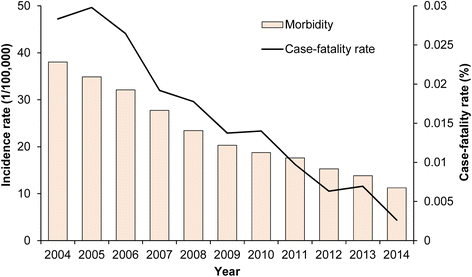
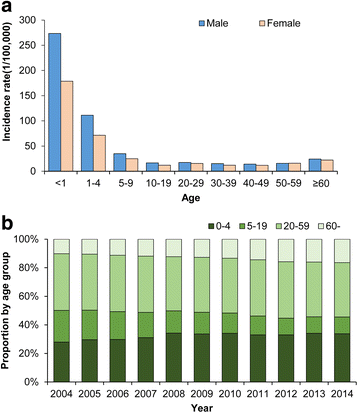
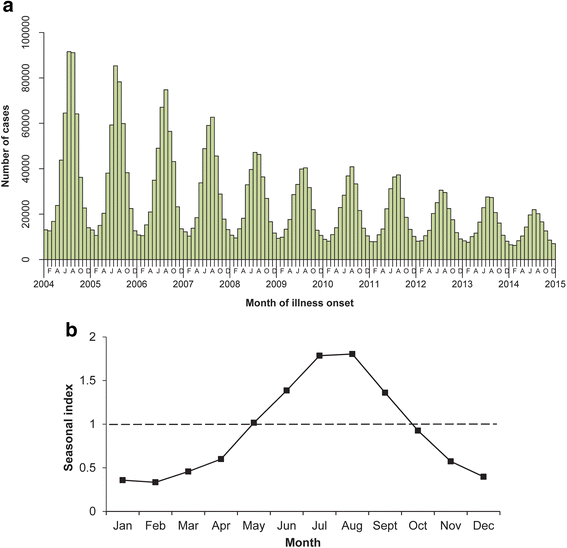
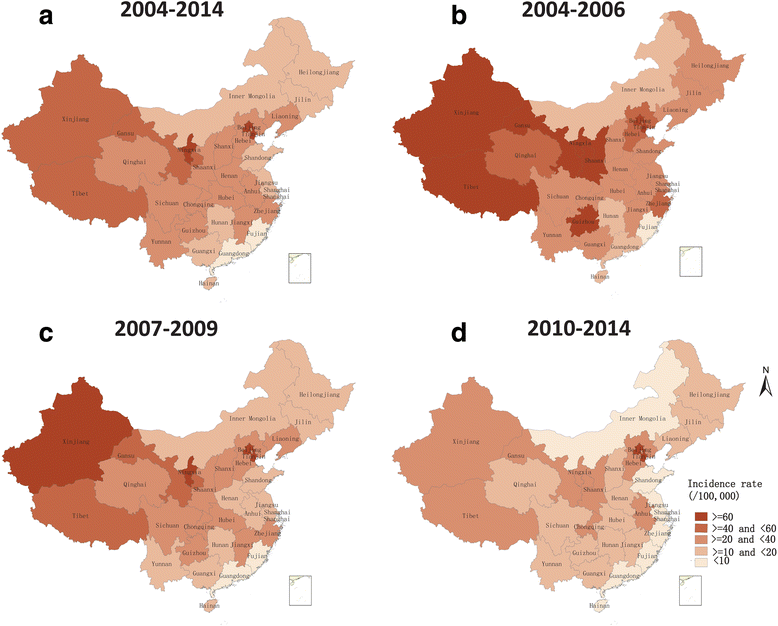
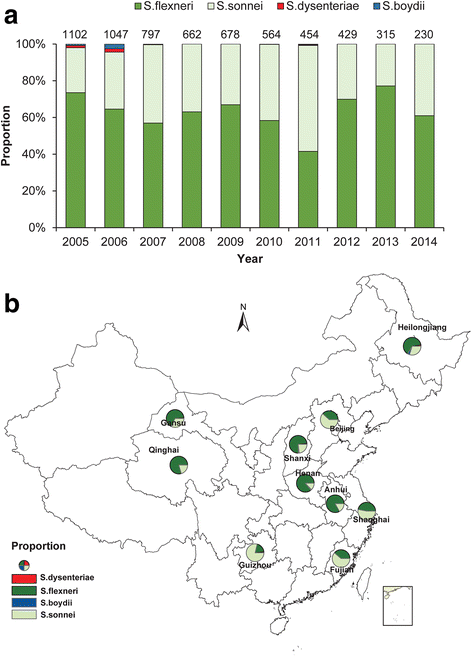
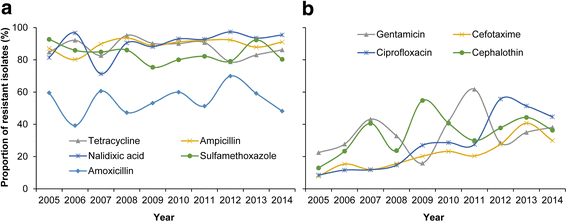
Similar articles
-
[Pathogenic surveillance and related factors on bacillary dysentery in Beijing, 2008-2017].Zhonghua Liu Xing Bing Xue Za Zhi. 2019 Feb 10;40(2):165-169. doi: 10.3760/cma.j.issn.0254-6450.2019.02.008. Zhonghua Liu Xing Bing Xue Za Zhi. 2019. PMID: 30744266 Chinese.
-
Surveillance of antimicrobial susceptibility patterns among Shigella species isolated in China during the 7-year period of 2005-2011.Ann Lab Med. 2013 Mar;33(2):111-5. doi: 10.3343/alm.2013.33.2.111. Epub 2013 Feb 21. Ann Lab Med. 2013. PMID: 23482897 Free PMC article.
-
Shigellosis in Nepal: 13 years review of nationwide surveillance.J Health Popul Nutr. 2016 Nov 4;35(1):36. doi: 10.1186/s41043-016-0073-x. J Health Popul Nutr. 2016. PMID: 27814742 Free PMC article.
-
Patterns of Bacillary Dysentery in China, 2005-2010.Int J Environ Res Public Health. 2016 Jan 27;13(2):164. doi: 10.3390/ijerph13020164. Int J Environ Res Public Health. 2016. PMID: 26828503 Free PMC article. Review.
-
Shigellosis in Taiwan: An old enteric pathogen with changing epidemiology and increasing antimicrobial resistance.J Microbiol Immunol Infect. 2024 Jun;57(3):346-353. doi: 10.1016/j.jmii.2023.10.015. Epub 2023 Nov 3. J Microbiol Immunol Infect. 2024. PMID: 37951802 Review.
Cited by
-
Pathogenic Surveillance of Foodborne Illness-Related Diarrhea - Beijing Municipality, China, 2013-2023.China CDC Wkly. 2024 Jun 14;6(24):568-573. doi: 10.46234/ccdcw2024.111. China CDC Wkly. 2024. PMID: 38934024 Free PMC article.
-
Concordance between Genotypic and Phenotypic Drug-Resistant Profiles of Shigella Isolates from Taiyuan City, Shanxi Province, China, 2005 to 2016.Microbiol Spectr. 2023 Jun 15;11(3):e0011923. doi: 10.1128/spectrum.00119-23. Epub 2023 May 30. Microbiol Spectr. 2023. PMID: 37249442 Free PMC article.
-
[Shigellosis attended in the emergency department of a regional hospital in southeastern Spain: from their presence to multiresistance].Rev Esp Quimioter. 2023 Jun;36(3):282-290. doi: 10.37201/req/121.2022. Epub 2023 Mar 21. Rev Esp Quimioter. 2023. PMID: 36942425 Free PMC article. Spanish.
-
A descriptive analysis of the Spatio-temporal distribution of intestinal infectious diseases in China.BMC Infect Dis. 2019 Sep 2;19(1):766. doi: 10.1186/s12879-019-4400-x. BMC Infect Dis. 2019. PMID: 31477044 Free PMC article.
-
Increasing clinical resistance rate of Shigella sonnei to cefotaxime in Jiangsu Province, China, between 2012 and 2015.Ann Transl Med. 2018 Jun;6(11):207. doi: 10.21037/atm.2018.05.43. Ann Transl Med. 2018. PMID: 30023370 Free PMC article.
References
-
- Bhattacharya SK, Sur D, Mahalanabis D. Public health significance of shigellosis. Indian Pediatr. 2012;49:269–270. - PubMed
MeSH terms
Substances
LinkOut - more resources
Full Text Sources
Other Literature Sources
Miscellaneous

